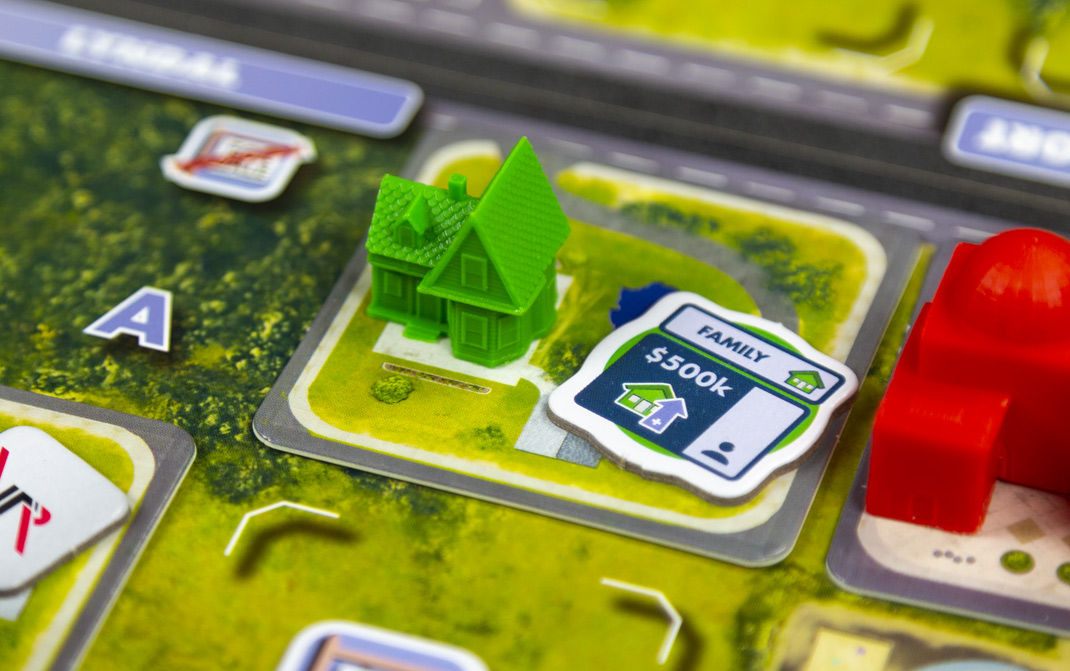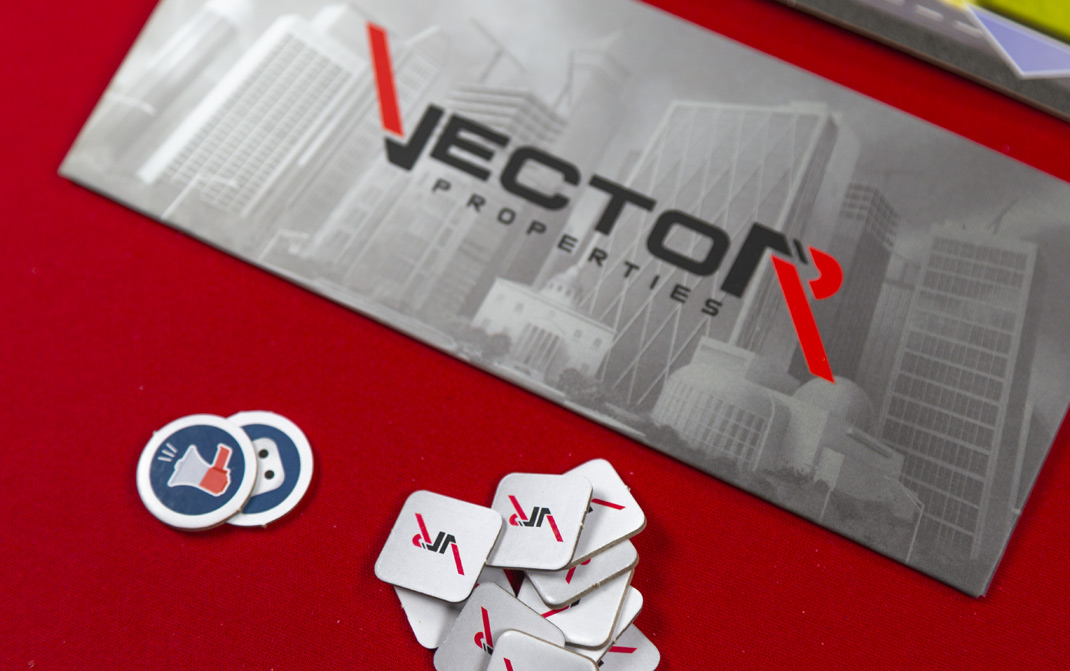Published by Naylor Games
Designed by James Naylor | Art by Donal Hegarty, Cze Lee & James Naylor
1-5 Players | 60-120 Minutes
The city of Humbleburg has had a sleepy history. Home to a few quiet residences, the townspeople have managed to fend off development despite being a convenient drive to the hustle and bustle of the big city. Shockingly, the city council announces an end to all zoning laws, creating a real estate Wild West overnight. Now the race is on to develop the city’s profitable empty lots at any cost – all but guaranteeing insane property values. As any good real estate developer knows: what goes up must come down… and it’s your ominous aim to take advantage of this erupting market before it all comes crashing down.
In Magnate: The First City, players will be buying property, developing the land into marketable real estate, drawing in tenants and enjoying the financial rewards. Like any true-to-life real estate situation, location is king. As you develop your properties you’ll also benefit from your neighbor’s projects – earning a boost for the surrounding land’s prosperity. As your wallet and the market gets fatter, it’ll be up to you to determine how long you should push your luck by hanging onto your property. Land prices will continue to skyrocket and big money is there for the taking, but if you stay in too long the market may collapse leaving you with peanuts in return. Winning the game is simple: be the most savvy developer and earn the most money in this economic, market-driven game that favors the bold.

HOW IT PLAYS
Players begin by taking on the persona of one of five local real estate companies. In addition you’ll receive some startup cash and a few advertising dollars to play with.
Six random neighborhood boards are chosen and placed surrounding the primary board containing the current residence, and their prior development of the city of Humbleburg.
The game takes place over an undetermined number of rounds. During each round the real estate market grows and evolves through a series of setup actions. Players then have the opportunity to purchase, develop and sell property amongst a number of action options. From there, the players actions render results to the market that not only push the value of the market up, but introduces risks that will eventually have their reckoning.

Each neighborhood features 9 lots. While some of the lots have seen some loose development, most will be available for purchase at some point during the game. Each round, a specific number of lots will become available for sale. The price of these lots is determined based on the current land price track. The land price track will increase as its affected by the player’s actions throughout the game.
In addition to lots for sale, the town also sees an increase in potential tenants represented by tiles.
After bidding for turn order, players take turns attracting new tenants into their previously developed properties and receiving rent from all residents. The quality of the neighboring areas play a big role in attracting new tenants. Living within driving distance to jobs and marketplaces might help bring in higher paying residential guests while industrial projects might turn away potential home-seekers. Players receive a number of dice based on these parameters and then roll to determine who they can attract. These dice rolls can be mitigated by a preemptive advertising campaign allowing you to improve your reach. Other additional dice bonuses come into play such as having a park near a residential property. It’s all very thematic.

After addressing all owned properties each player, in turn order, has the opportunity to purchase new properties, develop their current landholdings, sell or do other real estate-ish things such as consult for cash or gain additional advertising opportunities.
Selling a property is a delicate task as you can potentially earn more money as the neighborhood it belongs to begins to develop. Adjacent tenants often come with selling bonuses. This all represents added value based on your properties location. The formula is a little challenging at first, but you’ll get the hang of it since selling is key to success and waiting for the right moment can really bump up those paychecks.

Once each player has resolved their 3 actions for the round the Property Market phase commences. During this phase players will see land prices increase based on the number of plots sold that round as well as advertising spent. Players will draw risk cards pushing the market closer to a crash based on available tenants and increased land price among other things. Again, it’s all very well thought out and very thematic in how it all unfolds.
Play continues until the market crashes… and the thing is, you never know when that’s going to happen. You might have an idea or get a feeling, but each risk card carries a different crash value – so you never quite know how long you’ve got. Risk cards also determine the final property value after the market crashes. At the end of the game you add up all these negative market values and determine the ending property value each remaining, unsold property is sold for. This might mean a multi-million dollar property sells for a couple hundred-thousand because you couldn’t unload it in time.
In the end, the player with the most money in their wallet is the winner and crowned real estate king of Humbleburg.

PLAYING SOLO
Magnate comes with an AI system that introduces another player into the game. This can serve as a competitor in a 1-player game or another participant in your 2-4 player game. Like most AI players, it’s a little more work than I typically want to put into a solo mode, but it does provide that more flexible game experience. I didn’t use this extensively, but the AI did seem like a stout challenger – very difficult to defeat. I kinda like the idea of introducing him in a 2-player game and then determining the winner from the 2 real-life players.

COMPONENTS
While Magnate might have been successful with tiles featuring each property development, much of this game’s giant box is used to store a series of miniature buildings. These decently-sized models represent each type of land development option in the game. There is a nice, single-family home and giant, sky-rise apartment complex holding up to 5 tenants for residential builds. Commercial offers a standard, small office building capable of holding just 1 tenant and a superior office block with room for 3. Retail and Industrial also offer 2 variants each for their options.
The cardboard for the game boards is a little thin for my tastes. It’s fine in a normal game, but it does provide a bit of a contrast to the amazing building miniatures. The tenant tiles, various other tokens and player cards all get the job done. The game does come with a huge handful of 20 dice.
Normally I wouldn’t mention this, but I know it may potentially rub some people the wrong way. The game comes with paper money. I know, it’s the end of the world. This is clearly done to provide an alternative to a shield that game’s typically use to hide your hand. Instead, you get a “wallet” where the money can slide into. It keeps the money hidden from your opponents and doesn’t require the hassle of a big screen. I probably won’t be able to convince everyone, but it actually works and really didn’t bother me.

ARTWORK
Artwork in Magnate is fairly minimal. The box and neighborhood boards have a strong Sim City vibe that has to resonate with fans of the economic, city building genre. The graphic design on the property market is colorful, but most of all, clearly presented. Each step throughout the game is clearly presented on a player resource card or directly on the property market board.
The rulebook is clean and well laid out. There are lots of visual references and examples to help communicate the game’s ideas. One of the game’s more brilliant moves is a starter deck that carefully walks you through all aspects of playing the game. It’s super easy to follow and serves as an amazing learning tool to help you understand the game’s concepts. I really wish more games would incorporate something like this.

DEEP THOUGHTS
Magnate: The First City was a modest success on Kickstarter, but one that really caught my eye. I’m always up for a good city builder, but Magnate ups the ante by introducing an exceptional economic system that is both thematic and entertaining. Every mechanic in Magnate seems so carefully integrated into the theme that it results in a beautiful, next level experience.
While the concept of a city without zoning laws is a little far fetched, it’s one that really drives the pace of the game. You’re frantically working to build your empire in a short period of time. The market bust is inevitable so tension in the game increasingly builds as the game progresses – especially since you’re not 100% sure when that will happen. Your initial 3 actions on your first round seem plenty, but midway, you’re violently buying and selling land and by the end you are desperately clawing for ways to efficiently maximize every single move to guarantee you get in, build up and get out before the bottom drops out of the market. The tension is real here.
There are a number of standout aspects of Magnate, but the most engaging for me sits at the heart of the game. I love how the value of your property and potential ability to attract tenants rests in the interaction with the surrounding areas. If you build a residential area near a park, near other residential areas and with easy access to office/jobs and shopping you’re going to get a better return than if you’re next to a heavy, unattractive industrial zone. It makes sense, right?

While you’re working to build your own empire this isn’t a solitaire game by any means. Almost everything in the game’s ecosystem is affected by something someone else is doing. Each round begins with players bidding for the first player. I initially played Magnate with 2 players and the bidding didn’t play a huge role, but when I jumped up the player count, the value in winning the bid skyrocketed. If you don’t get first dibs, someone else will likely snag that choice piece of property right out from under you. That’s not to mention they’ll have the first choice in attracting the best tenants.
While you’re working against your opponents, their success can also play a major factor in your own mini-victories. Opponents developing complimentary land projects adjacent to yours and drawing the right tenants can seriously boost the sales price of your own property. This creates a really interesting and fun dynamic between all the players on the board.
Let me talk just briefly about drawing new tenants. This is the only point in the game that plays on luck. Rolling higher pairs of dice will give you the opportunity to draw higher-end tenants. This isn’t an exact science in real life and makes perfect sense that there would be some luck involved for this phase of the game. Magnate, on the other hand, provides ample opportunity to mitigate the dice through advertising and location – again, providing a wonderful mix of thematics to the functionality.
I could go on about the Property Market Phase and how each action has a reaction on the market as a whole. Infusing advertising, leveraging sold property and weighing tenants looking to move into the city all play a direct effect on how quickly the market blows up and the consequences waiting in the shadows when it does pop.

There were only a couple of negative points for me. I didn’t love how the tenant tokens sat on the game boards. You often find yourself having to carefully dig through them to determine your properties sale value or when drawing dice to bring in new tenants. If you’re not careful buildings can get bumped and boards can get moved. It’s not that big of a deal, but it can be annoying for people with sausage-size fingers.
I already addressed the contrast between the board quality and the miniatures. I really wish the player boards were a little thicker. Since the miniature buildings are so great, it really raises the expectations for the rest of the game.
VERDICT
Magnate: The First City is Monopoly if Monopoly was fun. The theme really shines here and it’s clear this was a passion project for designer James Naylor (he even put photos of his family on the money). The game’s miniatures and modular packaging (which help with setup and tear down) definitely contribute overall to a pricer game, but there is a ton of value. If you’re a fan of market-driven, economic games or more complex city builders this is going to hit the spot. The learning curve would be a little steep if it wasn’t for the fantastic starter deck taking you through all the details. Once you’ve got the game down, teaching isn’t too complicated, making this a great entry point for players looking to move into medium weight games. There is plenty of replay-ability and one that I imagine I’ll be playing years down the road. This was easily one of the best games I played in 2021 and I highly recommend it across the board.








